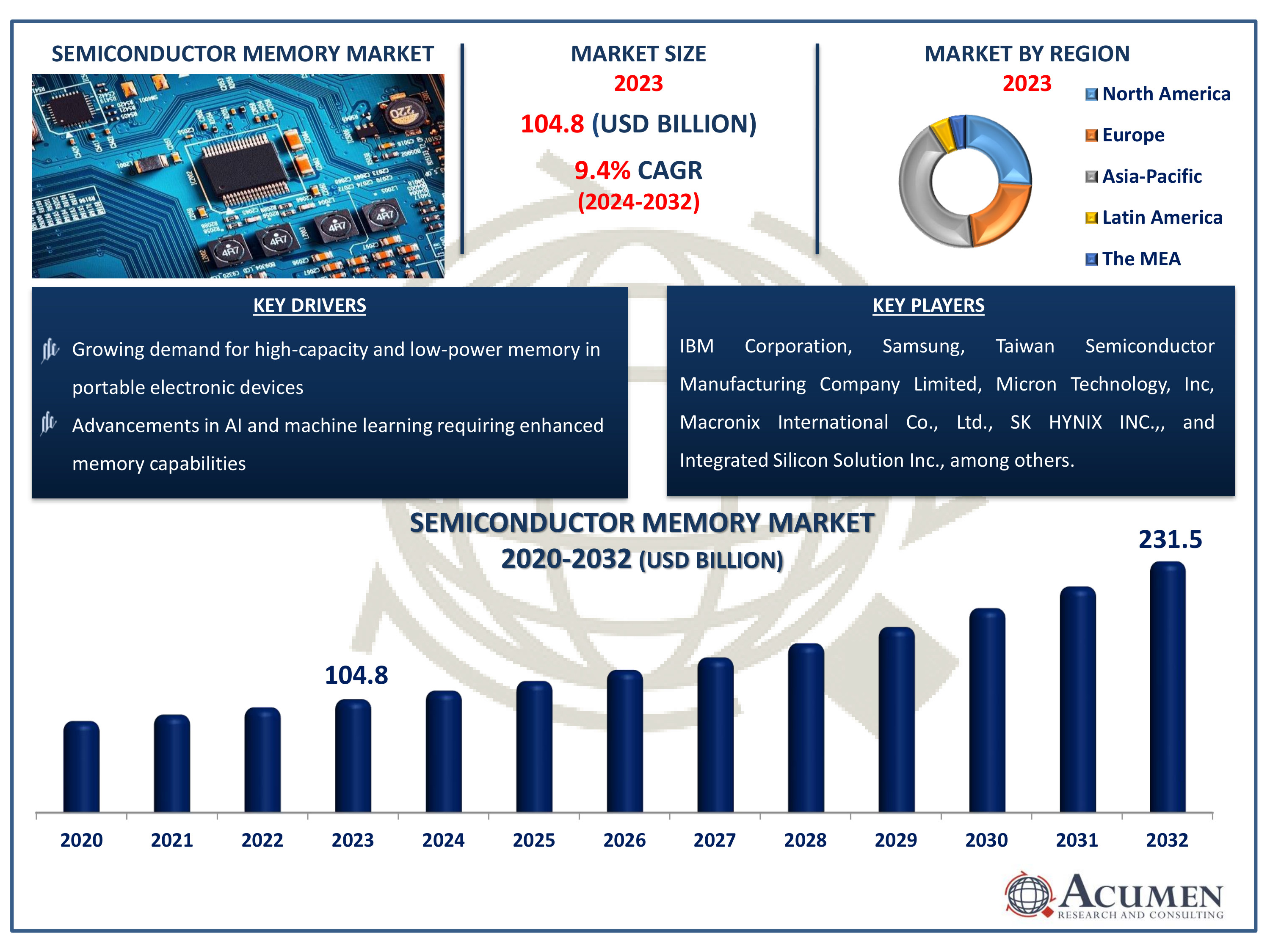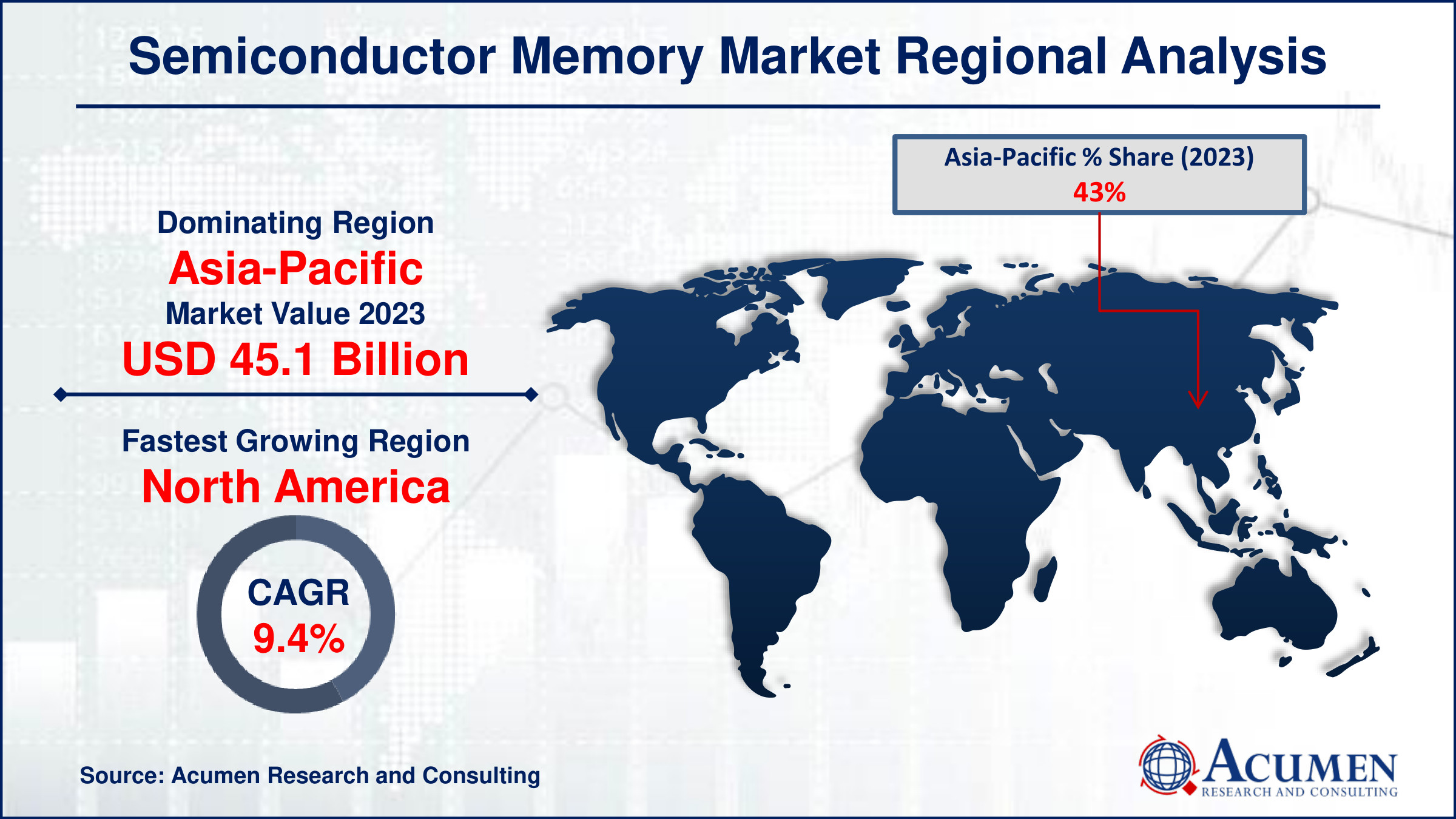Semiconductor Memory Market Size - Global Industry, Share, Analysis, Trends and Forecast 2024 - 2032
Published :
Report ID:
Pages :
Format :
Semiconductor Memory Market Size - Global Industry, Share, Analysis, Trends and Forecast 2024 - 2032
Report Coverage
- Industry Dynamics
- Market Size and Forecast Data
- Segment Analysis
- Competitive Landscape
- Regional Analysis with a Niche Focus on Country-Level Data
- High Level Analysis - Porter's, PESTEL, Value Chain, etc.
- Company Profiles of Key Players
- Option to Customize the Report As Per Your Specific Need
Request Sample Report
The Semiconductor Memory Market Size accounted for USD 104.8 Billion in 2023 and is estimated to achieve a market size of USD 231.5 Billion by 2032 growing at a CAGR of 9.4% from 2024 to 2032.
Semiconductor Memory Market Highlights
- Global semiconductor memory market revenue is poised to garner USD 231.5 billion by 2032 with a CAGR of 9.4% from 2024 to 2032
- Asia-Pacific semiconductor memory market value occupied around USD 45.1 billion in 2023
- North America semiconductor memory market growth will record a CAGR of more than 10.5% from 2024 to 2032
- Among type, the DRAM sub-segment generated around USD 51.3 billion revenue in 2023
- Based on application, the consumer electronics sub-segment generated 33% semiconductor memory market share in 2023
- Increasing investments in 5G infrastructure and related applications is a popular semiconductor memory market trend that fuels the industry demand

Semiconductor memory is an electronic device used as computer memory, essential for today’s electronic devices. It stores digital information using Integrated Circuit (IC) technology. The demand for high-capacity and low-power memory is rapidly growing as new advanced portable electronic devices enhance overall performance with reduced size. Semiconductor memory includes various types such as RAM (Random Access Memory), ROM (Read-Only Memory), flash memory, and cache memory, each serving specific functions in computing devices. RAM, for example, is crucial for temporary data storage and quick access, while flash memory is widely used for long-term data retention in devices like USB drives and SSDs (Solid-State Drives). These memory types contribute significantly to the efficiency and speed of electronic devices, making them indispensable in applications ranging from smartphones and laptops to industrial machinery and automotive systems. The continuous evolution in semiconductor memory technology drives innovation and supports the advancement of modern electronics.
Global Semiconductor Memory Market Dynamics
Market Drivers
- Growing demand for high-capacity and low-power memory in portable electronic devices
- Increasing adoption of IoT devices and smart home technologies
- Advancements in AI and machine learning requiring enhanced memory capabilities
- Expansion of data centers and cloud computing services
Market Restraints
- High production costs of advanced semiconductor memory
- Limited availability of raw materials and supply chain disruptions
- Intense competition leading to pricing pressures and reduced profit margins
Market Opportunities
- Development of next-generation memory technologies like MRAM and RRAM
- Expansion in emerging markets with rising demand for electronic devices
- Growing automotive sector adoption of semiconductor memory for autonomous driving systems
Semiconductor Memory Market Report Coverage
| Market | Semiconductor Memory Market |
| Semiconductor Memory Market Size 2022 | USD 104.8 Billion |
| Semiconductor Memory Market Forecast 2032 | USD 231.5 Billion |
| Semiconductor Memory Market CAGR During 2023 - 2032 | 9.4% |
| Semiconductor Memory Market Analysis Period | 2020 - 2032 |
| Semiconductor Memory Market Base Year |
2022 |
| Semiconductor Memory Market Forecast Data | 2023 - 2032 |
| Segments Covered | By Type, By Application, And By Geography |
| Regional Scope | North America, Europe, Asia Pacific, Latin America, and Middle East & Africa |
| Key Companies Profiled | IBM Corporation, Samsung, Taiwan Semiconductor Manufacturing Company Limited, Micron Technology, Inc, Macronix International Co., Ltd., SK HYNIX INC., TOSHIBA ELECTRONIC DEVICES & STORAGE CORPORATION, Integrated Silicon Solution Inc., Infineon Technologies AG, and Texas Instruments Incorporated. |
| Report Coverage |
Market Trends, Drivers, Restraints, Competitive Analysis, Player Profiling, Covid-19 Analysis, Regulation Analysis |
Semiconductor Memory Market Insights
The proliferation of smartphones, ongoing technological advancements, and digital evolution in the electronic industry are significantly escalating the overall market growth. The growing popularity of smartphones and the introduction of technologically innovative smart devices are some of the major factors positively influencing the growth of the global semiconductor memory market. Digital advancements in the consumer electronics industry and the increasing utilization of memory-based components in technologically advanced products are fueling the market's global expansion. The rising consumption of semiconductor components across various industries such as automotive, consumer electronics, and IT & telecom is driving the demand for semiconductor memory.
Additionally, the integration of IoT devices into the consumer and retail sectors and the growing popularity of IoT technology across all industry verticals are further propelling market growth. Companies worldwide are increasingly deploying highly efficient and powerful semiconductor memory solutions with high storage capabilities to address data center complexities, thereby boosting the semiconductor memory market. This trend is particularly evident as businesses strive to enhance data management and processing efficiency, leading to greater demand for advanced memory solutions.
However, various government regulations regarding different manufacturing standards are extensively affecting the sourcing of raw materials, consequently driving up the overall product cost. This factor is expected to hamper the growth of the global semiconductor memory market over the forecast period. Additionally, the increasing costs associated with maintaining and upgrading existing fabrication plants may also hinder market growth. The need for substantial investments in R&D and infrastructure to keep pace with technological advancements adds to the financial burden on manufacturers, potentially limiting their expansion capabilities.
Despite these challenges, the semiconductor memory market is poised for robust growth, driven by the continuous innovation and the ever-increasing demand for more efficient and powerful memory solutions across various sectors. As the digital landscape evolves, the market is expected to overcome these obstacles, propelled by the relentless pursuit of technological excellence and the expanding application of semiconductor memory in diverse industries.
Semiconductor Memory Market Segmentation
The worldwide market for semiconductor memory is split based on type, application, and geography.
Semiconductor Memory Types
- SRAM
- MRAM
- DRAM
- Flash ROM
- Others
According to semiconductor memory industry analysis, the dynamic random-access memory (DRAM) segment holds the largest market share due to its widespread application in various high-performance computing environments. DRAM is integral to personal computers, servers, and mobile devices because of its ability to provide high-speed data access and storage. Its structure allows for rapid reading and writing of data, making it essential for applications requiring quick data processing. The continuous demand for enhanced computing performance, driven by the proliferation of smartphones, tablets, and other smart devices, fuels the growth of the DRAM segment. Additionally, the expansion of data centers and the increasing adoption of cloud services further boost the demand for DRAM. Its ability to scale with advancing technology ensures its dominance in the market, making it a crucial component in the evolving digital landscape.
Semiconductor Memory Applications
- Consumer Electronics
- Automotive
- Industrial
- Medical
- Aerospace And Defense
- IT & Telecommunication
- Others
The consumer electronics segment leads the market due to the rapid adoption and continuous innovation in devices like smartphones and it is expected to increase during the semiconductor memory industry forecast period, tablets, laptops, and smart home gadgets. This segment drives substantial demand for semiconductor memory, as these devices require efficient and reliable memory solutions to enhance performance, storage capacity, and energy efficiency. The rising consumer expectations for faster, more responsive gadgets with greater storage capabilities further propel this demand. Additionally, advancements in wearable technology and smart appliances contribute to the growth of this segment. The shift towards smart and interconnected devices in households, powered by IoT (Internet of Things) technology, also plays a significant role in maintaining the Consumer Electronics segment's dominant position in the market. As technology evolves, the need for advanced semiconductor memory solutions in consumer electronics continues to grow, reinforcing its leading market position.
Semiconductor Memory Market Regional Outlook
North America
- U.S.
- Canada
Europe
- U.K.
- Germany
- France
- Spain
- Rest of Europe
Asia-Pacific
- India
- Japan
- China
- Australia
- South Korea
- Rest of Asia-Pacific
Latin America
- Brazil
- Mexico
- Rest of Latin America
The Middle East & Africa
- South Africa
- GCC Countries
- Rest of the Middle East & Africa (ME&A)

Semiconductor Memory Market Regional Analysis
In terms of semiconductor memory market analysis, Asia-Pacific dominates the industry, owing to its strong production infrastructure, significant technological investments, and the presence of major industry players like Samsung, SK Hynix, and TSMC. China, South Korea, and Taiwan are leaders in semiconductor production and innovation, thanks to strong home demand and a robust export market. The region's supremacy is bolstered by considerable R&D operations, government programs to promote the semiconductor industry, and the fast adoption of advanced technology in consumer electronics, automotive, and industrial markets. Furthermore, the burgeoning middle class and rising disposable incomes in these countries increase demand for electronic gadgets, propelling the semiconductor memory market.
On other hand, North America is the fastest-growing region during the semiconductor memory market forecast period. This expansion is driven by the region's strong technological foundation, significant investments in data centers, and the spread of cloud computing services. The presence of major technological businesses and considerable R&D operations in the United States and Canada encourages innovation and the development of enhanced memory solutions. Furthermore, increased demand for high-performance computing, AI, and IoT applications drives market expansion. Government assistance for semiconductor research and development, including legislation and financing, also helps to the rapid rise of the North American semiconductor memory sector.
Semiconductor Memory Market Players
Some of the top semiconductor memory companies offered in our report includes IBM Corporation, Samsung, Taiwan Semiconductor Manufacturing Company Limited, Micron Technology, Inc, Macronix International Co., Ltd., SK HYNIX INC., TOSHIBA ELECTRONIC DEVICES & STORAGE CORPORATION, Integrated Silicon Solution Inc., Infineon Technologies AG, and Texas Instruments Incorporated.
Frequently Asked Questions
How big is the semiconductor memory market?
The semiconductor memory market size was valued at USD 104.8 billion in 2023.
What is the CAGR of the global semiconductor memory market from 2024 to 2032?
The CAGR of semiconductor memory is 9.4% during the analysis period of 2024 to 2032.
Which are the key players in the semiconductor memory market?
The key players operating in the global market are including IBM Corporation, Samsung, Taiwan Semiconductor Manufacturing Company Limited, Micron Technology, Inc, Macronix International Co., Ltd., SK HYNIX INC., TOSHIBA ELECTRONIC DEVICES & STORAGE CORPORATION, Integrated Silicon Solution Inc., Infineon Technologies AG, and Texas Instruments Incorporated.
Which region dominated the global semiconductor memory market share?
Asia-Pacific held the dominating position in semiconductor memory industry during the analysis period of 2024 to 2032.
Which region registered fastest CAGR from 2024 to 2032?
North America region exhibited fastest growing CAGR for market of semiconductor memory during the analysis period of 2024 to 2032.
What are the current trends and dynamics in the global semiconductor memory industry?
The current trends and dynamics in the semiconductor memory industry include growing demand for high-capacity and low-power memory in portable electronic devices, increasing adoption of IoT devices and smart home technologies, advancements in AI and machine learning requiring enhanced memory capabilities, and expansion of data centers and cloud computing services.
Which application held the maximum share in 2023?
The consumer electronics application held the maximum share of the semiconductor memory industry.



